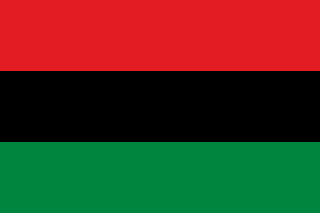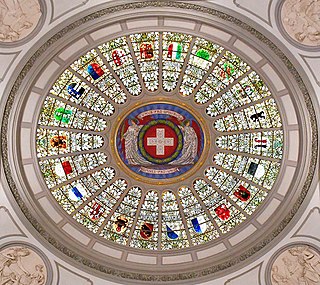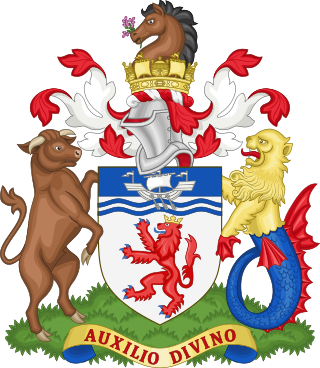
Devon is a ceremonial county in South West England. It is bordered by the Bristol Channel to the north, Somerset and Dorset to the east, the English Channel to the south, and Cornwall to the west. The city of Plymouth is the largest settlement, and the city of Exeter is the county town.

The flag of South Africa was designed in March 1994 and adopted on 27 April 1994, during South Africa's 1994 general election, to replace the previous flag used from 1928-1994.

In British maritime law and custom, an ensign is the identifying flag flown to designate a British ship, either military or civilian. Such flags display the United Kingdom Union Flag in the canton, with either a red, white or blue field, dependent on whether the vessel is civilian, naval, or in a special category. These are known as the red, white, and blue ensigns respectively.

The Pan-African flag is a tri-color flag consisting of three equal horizontal bands of red, black, and green. The Universal Negro Improvement Association and African Communities League (UNIA-ACL) formally adopted it on August 13, 1920, in Article 39 of the Declaration of the Rights of the Negro Peoples of the World, during its month-long convention at Madison Square Garden in New York City. Variations of the flag can and have been used in various countries and territories in the Americas to represent Garveyist ideologies.

The national flag of Italy, often referred to in Italian as il Tricolore, is a tricolour featuring three equally sized vertical pales of green, white and red, national colours of Italy, with the green at the hoist side, as defined by article 12 of the Constitution of the Italian Republic. The Italian law regulates its use and display, protecting its defense and providing for the crime of insulting it; it also prescribes its teaching in Italian schools together with other national symbols of Italy.

The flag of Portugal is the national flag of the Portuguese Republic. It is a rectangular bicolour with a field divided into green on the hoist, and red on the fly. The lesser version of the national coat of arms of Portugal is centered over the colour boundary at equal distance from the upper and lower edges. Its presentation was done on 1 December 1910, after the downfall of the constitutional monarchy on 5 October 1910. However, it was only on 30 June 1911, that the official decree approving this flag as the official flag was published. This new national flag for the First Portuguese Republic, was selected by a special commission whose members included Columbano Bordalo Pinheiro, João Chagas and Abel Botelho. The conjugation of the new field color, especially the use of green, was not traditional in the Portuguese national flag's composition and represented a radical republican-inspired change that broke the bond with the former monarchical flag. Since a failed republican insurrection on 31 January 1891, red and green had been established as the colours of the Portuguese Republican Party and its associated movements, whose political prominence kept growing until it reached a culmination period following the Republican revolution of 5 October 1910. In the ensuing decades, these colours were popularly propagandised as representing the hope of the nation (green) and the blood of those who died defending it (red), as a means to endow them with a more patriotic and dignified, therefore less political, sentiment.

The flag of Kenya is a tricolour of black, red, and green with two white edges imposed with a red, white and black Maasai shield and two crossed spears. The flag is based on that of Kenya African National Union and was officially adopted on 12 December 1963 after Kenya's independence.

The current national flag of Lesotho, adopted on the 40th anniversary of Lesotho's independence on 4 October 2006, features a horizontal blue, white, and green tricolour with a black mokorotlo in the center. The design is intended to reflect a state that is both at peace internally and with its only neighbour South Africa, replacing the old flag design that featured a military emblem of a shield, spear and knobkerrie.

Each of the 26 modern cantons of Switzerland has an official flag and a coat of arms. The history of development of these designs spans the 13th to the 20th centuries.

The Flag of Devon, properly St Petroc's Cross, is the flag of the English county of Devon. It is dedicated to Saint Petroc, a local saint with numerous dedications throughout Devon. It is notable for its creation through two web-based polls.

The coat of arms of Malaysia is a coat of arms comprising a shield or escutcheon, two tigers for supporters, a crescent and fourteen-pointed star for a crest and a motto. As the Malaysian coat of arms descended from that of the Federated Malay States under British colonial rule, it resembles European heraldic designs.

The coat of arms of Egypt is known as the Republican Eagle or Egyptian Golden Eagle, is a heraldic golden eagle, facing the viewer's left (dexter). The eagle's breast is charged with an escutcheon bearing the red-white-black bands of the flag of Egypt rotated vertically, whilst the eagle's talons hold a scroll bearing the official name of the state written in Kufic script. The earliest version of the Eagle of Saladin was that used as the flag of Saladin, the first Sultan of Egypt, whilst the modern version of the eagle was adopted during the Egyptian Revolution of 1952. Subsequently, the modern design of the Eagle of Saladin was adopted as the coat of arms of numerous other states in the Arab World, namely the United Arab Republic, North Yemen, Iraq, South Yemen, the Libyan Arab Republic, and Palestine. The current eagle was modified in 1984 to its present form.
In British heraldry, vert is the tincture equivalent to green. It is one of the five dark tinctures called colours.
The flag and coat of arms of Kedah are the state symbols of Kedah, Malaysia. Very little distinction is present between the flag and coat of arms of the state, as the flag consists of only a red field with the state arms on the upper hoist.

Devon County Council is the county council administering the English county of Devon. Based in the city of Exeter, the council covers the non-metropolitan county area of Devon. Members of the council (councillors) are elected every four years. Almost all councillors are members of the major national political parties.
The flag and the coat of arms of Negeri Sembilan are state symbols of Negeri Sembilan, Malaysia. The symbols are predominantly depicted in red, black and yellow, traditional colours of the Minangkabau people who are the original settlers in the present-day state. Also recognised in the symbols are the political history of Negeri Sembilan, its ruler, and the state's past relationship with the British Empire.

The flag of Budapest is the official municipal flag of Budapest, Hungary. The current design features the city's coat of arms on a white field. The top and bottom edges of the flag are occupied by alternating red and green isosceles triangles. It has been in effect since 15 September 2011, following a decree from the General Assembly of Budapest.
















